|
Bonanza
tram terminal at the Kennecott discharge station & mill
--Candy Waugaman Collection |
Henry Jackson looked over his five new crew members. “Roger, I understand you knocked down one of our men while he was standing on the coach
platform of the train yesterday.” “What difference does that make? It was a damned Siwash I knocked over. Besides, we
got ganged up on.” “Yes, so I heard. I really feel sorry for you guys. Five to one in your favor, and you
got ganged up on. I’m going to give a piece of advice to all of you. It does
not matter to me or anyone else what you think of any man or group of men here.
That’s between you and them. But if you start a fight--and you definitely
started that one Roger--we have a problem. If anything like that
happens again, we’ll run you all off. “I wouldn’t be calling those Indians “siwash” either, if I were you. It sets them off. You
have to work with them, so watch your language. “It’s best if all of you stay clear of the Indians. They’re the paint crew, and those two
older two do work that puts most everyone else to shame. Our yard crew serves
as the support for them, so let’s do our part. By the way, that guy Cap who
downed all five of you is a champion boxer. We put him up against someone much
bigger who thought he was really good. He had to leave. Cap’s no one to
mess with. “We have several loads of lumber to haul up to the aerial tram loading dock. Let’s get to
work.” Johnny, Charles, and Cap stood in the paint shop looking at the newly painted gray
floor. It was finally dry. “Well, Cap, the floor paint sure improves the place. That spilled red just didn’t look good. The
old floor needed painting anyway. Still smells like wet paint, though.” “This is where dad worked all these years?” “This was it, Charles. Except for the paint cans we had to haul out of here it was a very
neat shop. He left it ready for the next job. How are you with heights?” “I’m not like you, Johnny. I’d prefer to stay on the ground.”
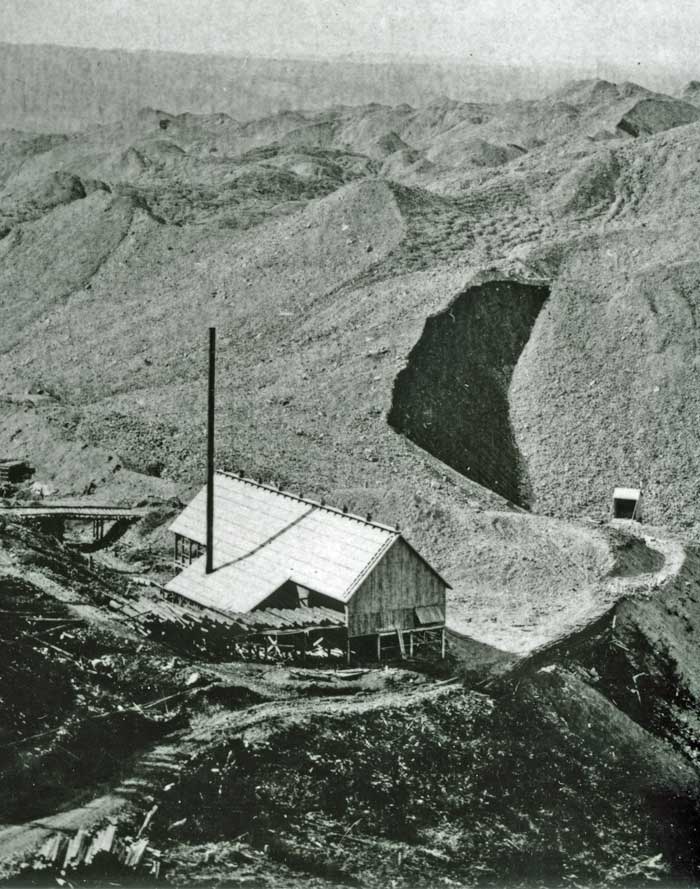 |
The original Kennecott
sawmill was probably the oldest building on the property since it was
needed in order to construct the other early log buildings and then to
cut lumber for the frame structures. Image taken in 1907. --AMHA |
|
By 1912 several frame
structures had been constructed on the Kennecott site. Here you see a
load of lumber at the sawmill that would eventually become a carpenter
and paint shop |
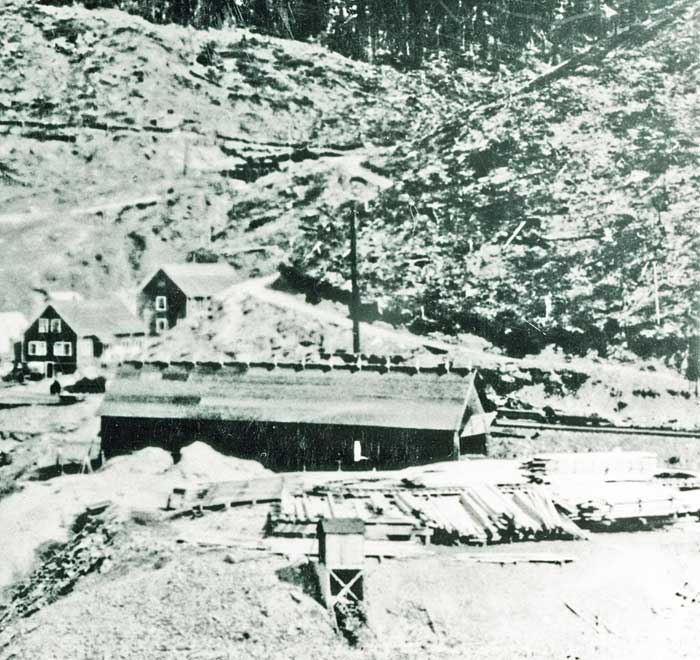 |
|
“Cap and I will need you on a temporary platform with us which the carpenters are building along
the top of the mill. You don’t need to get way out there with us, but you’ll
still be way up there. You think you can do it, Charles?” Charles looked at Johnny, then Cap, then swallowed hard, hesitated and finally answered. “I’ll anything you need, big brother. That’s what I’m here for. I really don’t like heights,
but I’ll go out there if that’s what you want.” “That’s what I thought. The scrapers, brushes and extensions are all here. We’ll take those
and a can of thinner each and walk on up there. By now the carpenters and
laborers should have already started.” Johnny examined the platform, which was being extended from the far northeast corner of the top
of the mill as planned. The yard crew had brought up some eight-foot ladders as
well. He followed along the platform as far as it went, inspecting the
condition of the old paint. “Henry, this area down here will need scraping. I’ll leave that to your crew while the three
of us begin at the back end of the mill on the Jumbo tram terminal side.” The three of painters set up for the job. Johnny sent Charles to the shed for a five-gallon can. Cap worked the lid open and began stirring. Johnny examined
the color. It was a very light gray. He shook his head. The back end of the
mill required only minimal scraping. He set his brother and Cap to work on the
small scraping job while he brushed on the first of the new light-gray paint
along the wall where the platform started. Henry Jackson wandered over to look at the fresh red paint and was startled to see light gray
being applied. “Johnny! What are you doing? Where’d you get that? It looks like floor paint!” “I guess no one told you, Henry, that this year the mill building is gray. Yes, this is it.
Gray paint. The management says gray and gray it is.” He gave a wink toward
Henry and continued. “Management is never wrong. We all know that. If that’s what they want, we sure have enough
of it stacked up here, though no one bothered to tell me it was light-gray
paint. Not that I need to be told.” Henry wandered back up the scaffold toward the front of the mill. Johnny smiled at Cap, who
gave him a discreet, knowing look. They had become a party to the inside
knowledge of a goof by management and both intended to keep it that way.
Johnny kept a wary eye on the yard crew, not trusting any of the new ones from Cordova. The
crew went on as though the Indians weren’t there. He remained on alert,
expecting nothing but evil from those men. The carpenter crew under Chris Jensen kept the yard crew busy running back and forth for
material. The scaffolding was going up much more rapidly than either Johnny or
Chris had expected. By the end of the day the carpenters had extended it all
the way down the north wall, then wrapped it around the front, just over the
roof of the elevator cap. This was the critical point where the platform
cables would be anchored that would lower Cap and Johnny down the west-facing
wall from the twelfth floor to the eighth. It was a long drop. If one were to
fall straight down from the top level, he would hit the first roof five stories
down. If he did not crash through there, he would roll down a long series of
six steep roofs all the way to track grade, where a final twenty-five foot drop
would surely finish him off. The three Indian painters walked gingerly down the two plank-wide platform to the front of
the mill. The platform stopped short of the northwest end of the building. At
that end the men had to climb an eight-foot ladder which led to the platform
over the top of the elevator cap. This was the top level of scaffolding. It
continued around the thirteenth floor level, finally ending at the rear of the
conveyor cap. This was the highest level, immediately behind the elevator cap.
It topped the building off at the fourteenth level. Johnny looked at the
scaffold work. It was well-anchored and appeared adequate to support the
cables which would be attached to the narrow front end of the mill.
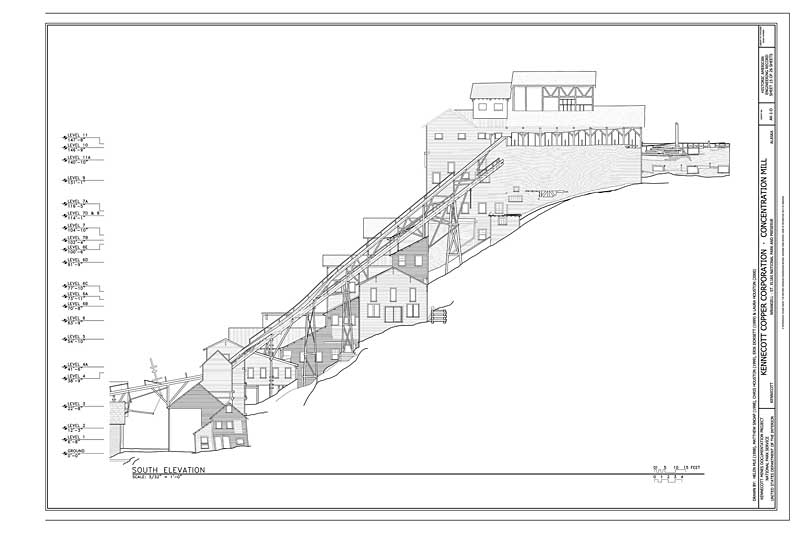 |
Kennecott mill profile as
of 2005 --Historic American Engineering Record |
“I’m not sure how they’ll do the rigging, but this platform looks like it should do the job.” Charles, from this very high vantage point was looking south in the direction of the west
barrack, which appeared very small from the top of the mill. He realized with
some trepidation that he had never been so high up in his life. Cap looked
down the Kennicott Glacier toward the distant Chugach Range and was pleased.
Fortunately, there was almost no wind. This was no place to be in the face of
gusty winds, even though the temporary hand rails the carpenters had installed
at this high level seemed quite stable. “The carpenters did well,” Cap observed. “Yes, they took on this job quickly and expertly from what I can see. This is much better than
anything I would have done. But that’s Chris Jensen. He’s reputed to be the
best in the territory. Looks good. Let’s head back. They passed by the painted
area, which had reached the point where the Jumbo tram terminal angled to meet
the Bonanza tram. These two tram terminals met each other at the back of the
mill in a Y-formation. The mill was built in a straight line with the Bonanza
tram, which headed straight east, while the Jumbo tram met the mill at a
thirty-degree angle from the northeast. Over the next week the painters would
finish the north wall. Then the dangerous hanging platform work over the high
west face of the mill would begin. In the evenings after work the billiards tables were kept busy. Johnny found himself challenged
by Roger Hyde, the man he had struck in defense of this brother Charles. Roger
was no match for Johnny at pool. He only played Johnny to try to unnerve him.
Roger Hyde had an obvious chip on his shoulder. The next man to challenge
Johnny was Kevin James, then Scott Sommers, then the other two who had been
knocked down by Cap. For some reason, the five men had chosen Johnny, rather
than Cap, as their first target. Cap and Charles sat on a nearby bench watching
it all. Each man shot in a hard and angry fashion. They routinely made a point of following each other
in a game of nerves against Johnny, subtlety revealing their grudge against all
three Indians. Johnny could see the unmistakable predatory look in the eyes of
each of these men. They talked with other whites in an attempt to turn as many
of them against the three Indians as possible. An electric charge ran
through the air whenever the men played against Johnny. They never challenged
Cap. Only Johnny. After a few days of this psychological warfare, Johnny had
enough. When he saw Roger Hyde enter the room, he left, followed by Cap and
Charles. The three never left each other’s sight. They never returned to the
billiards tables while Roger Hyde and the others remained in camp. “They’ve run us out of the billiards hall, Cap.” “Better that, than out of camp. Let them have the place. Who needs it? We can do other
things. Let’s play some poker.” “Sound’s good to me, Cap. Hope you’ve got betting money.”
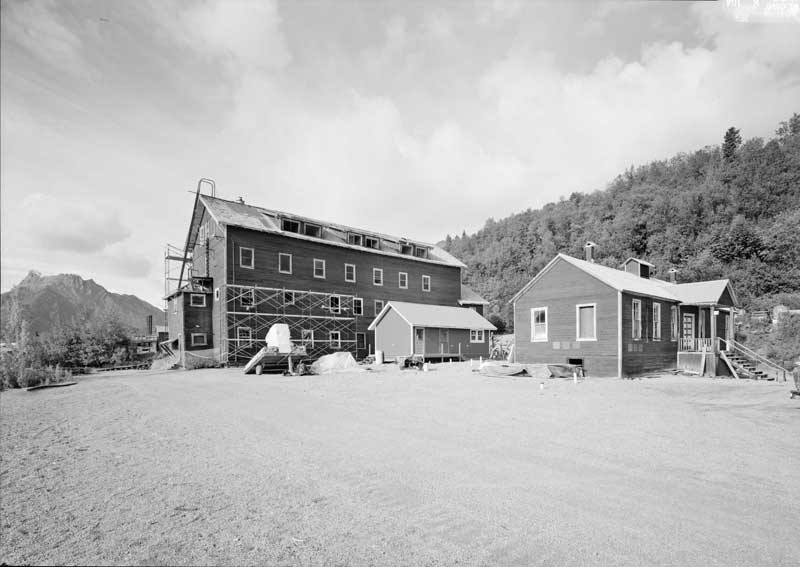
|
West
Bunkhouse in recent years --Historic American Engineering Record |
It was stuffy and hot in the room, as an early dry summer turned into a very hot one. Johnny
pulled off his heavy shirt first. He was already sweating, but this was partly
due to his own anxiety after that pool game. The window view to the north
includes all of the mill top where the painting was now underway. He looked up
toward the new platform which was wrapped around the top of the building. “One of these days the white men will make a comfortable shirt. These are fine for work, but
they’re sure not very comfortable. Like wearing canvas.” “I don’t feel right with those Cordova men around, Sla’cheen. They’re troublemakers.
All of them. Trouble. We have to be on guard wherever we go around here.” “They ran us out of the billiards hall, but so far we’ve been able to eat in peace, at
least.” “That’s because all the white men have learned to stay clear of us when we’re eating. I give
them my most ferocious look, and they leave.” Johnny couldn’t help laughing upon seeing the look Cap revealed.
“You’re very good at it, Cap. Who needs a vicious guard dog when we have you?” He laughed until he started coughing.
Charles remained completely and blissfully detached from all this. He
sensed something wrong, but remained unconcerned. He was fascinated with the
place, especially the mill building. He stood up next to his brother and looked
out at the mill for the longest time. Then he looked down. Below was yet
another long line of ore cars being loaded for the return to Chitina. “I was six when the first train came through our town from Kennecott, though back then I think
they called it something else.” “It was Bonanza then. There was no Kennecott, just the Bonanza Mine. The other names came
later. Now there are five mines, including that weird Glacier mine which really
is a glacier, though it’s a rock glacier. Never heard of those rock glaciers
before, and I grew up around here. We’re part of the first generation to see
this operation almost from the beginning, at least the railroad end of it” “Yes, big brother--Soon’ga” “No, Skeel’eh, call us sla’cheen. You’ve earned that,” Johnny interjected. Charles looked very pleased at that and continued.
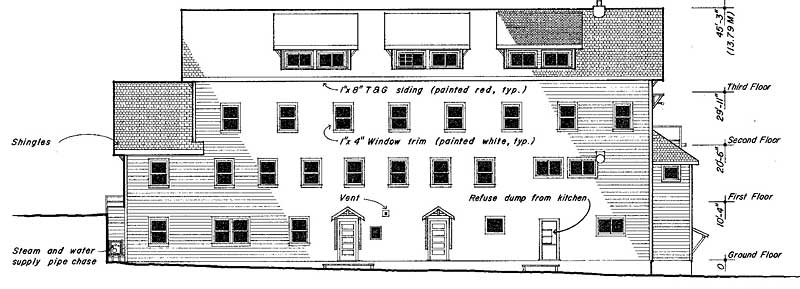 |
Profile of the north face
of the West Bunkhouse --HAER |
“What I was starting to way was that none of us were up here back then. I always wanted to
see the place where so much ore came from. Now I’m finally here. I’m working
here, just as Dad did. He would come down from here to visit us, but not very
often. He said the family could not visit him up here. Now he’s gone and we’re
here.” “Some of my friends, even some of your friends, may criticize me for this, but I like it
here. Especially because you, my sla’cheen , are here. I would not want
to be here otherwise. I’ll never forget this. You, my older skeel’eh
went to the trouble to include me. I’m not ashamed to be here at Kennecott with
you. I love it here. I don’t pay any attention to those evil men, because I
know deep inside me that this is really our place. That’s why the thought
of them doesn’t bother me.” Johnny was still sweating. The beads were slowly running down around his chest and back.
“You make me feel hot. I know it is stuffy in here, but not that hot.” He looked at Cap, who was now pulling off his own heavy shirt. Charles did likewise. The
three of them sat down in a small circle on the floor on top of their potlatch
blankets, facing each other, feeling very Indian, very much a part of each
other, and at the same time very much alone. “This is like being in the sez’el without the fire,” Charles observed. “Yes, Sla’cheen, and like in those old days when we shared the sez’el with
our grandfather Nicolai, now it is I who want you to keep silent.” Cap never spoke. He stared straight ahead into space somewhere between Johnny and Charles. Charles felt particularly connected to himself as an Indian when Cap
was around. Cap had a very strong spiritual quality about him much like that of
Nicolai or Doc Billum.
I really miss Shee-ya. It felt so good to be around him. So safe. So magical. Like
anything was possible. He was great. Cap has become what Shee-ya was.
Cap was beginning to feel the same sense of anxiety as Johnny had. But the three of
them felt safe in the small circle. They took great comfort in each other’s
presence. Johnny was anxious by nature. He would always be the first to tense
up and this would show in small ways, such as his tendency to perspire, though
he rarely revealed any physical fear. Johnny prided himself in that. He was a
natural daredevil. A sense of alarm was slowly seeping into Cap’s inner being. Johnny and Charles were
facing him in the circle and could not see through the window. Cap was
temporarily brought out of his trance by something at the top of the mill that
presided in silence over everything in camp. There it was, a solitary raven
flying in a circle high above. Then there were two. Then four. His sense of
danger was confirmed. The three of them were no longer alone at Kennecott. Now
there was a spirit with them. Cap sensed it was evil. The three leaned in
toward each other, all gradually falling into a trance which lasted well into
the evening. Charles fell over onto his blanket first. Like the others, he
stayed in that position until morning. . Johnny fell over next, also falling
onto his own blanket where he remained perfectly still until morning. Cap was
the last to fall, remaining in his trance flat on the floor just like the others
until morning. Once again he found himself walking the tracks in the blinding
sunlight. This time he was completely alone. Something was moving toward him
at a rapid speed. He was unable to leave the tracks. He could hear that hollow
sound of a train whistle. What was it really? When the three finally emerged from their room in the morning, they would all be operating as
one, ready for whatever danger might lie out there, and as completely in tune
with each other as three sla’cheen could be.
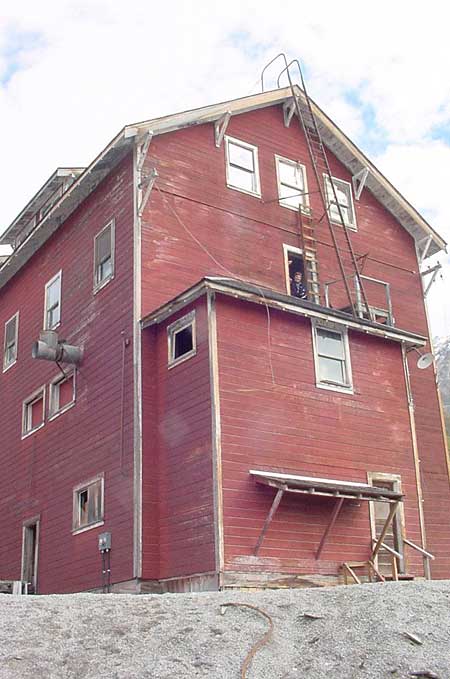 |
The author on the second
floor of the West Bunkhouse in 2005 |
|
|
 |
|
|
|
|
No comments:
Post a Comment